What is a potato and what family does it belong to, full description with photo
There is not a person in the world who has not tried potatoes. For some it is a staple food, for others it is a source of extra calories. Potatoes are familiar to our diet, but how much do we know about the plant itself, its composition and origin, the benefits and harms for the body? Let's talk about this in more detail.
What are potatoes: description
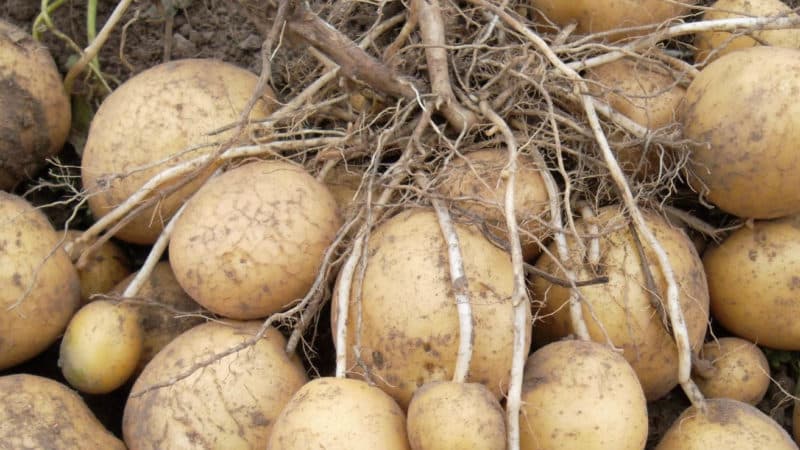
Potatoes are an amazing vegetable that feeds, heals and gives water all year round:
- There are more than 3,000 known ways to prepare potato dishes;
- used in traditional and folk medicine;
- used as a raw material for the production of ethyl alcohol.
Potato tubers are a storehouse of vitamins. In addition to water, starch (about 20%), proteins, fats, the root vegetable contains potassium, phosphorus, magnesium, sodium, calcium, iron, large quantities of vitamins C, B1, B2, B6 and malic, folic, citric acids.
The highest content of potassium, which is beneficial for the heart, blood vessels and nervous system, is found in the peel and pulp under the peel. To preserve this microelement, nutritionists advise cooking potatoes in their jackets, that is, whole, without peeling. Boiled or baked potatoes retain the maximum nutrients.
In terms of vitamin C content, potatoes are equivalent to oranges - 200 g of tubers contain the daily requirement.
Reference. After the spread of potatoes in Europe, scurvy epidemics stopped - eating the vegetable covered half the daily dose of ascorbic acid.
The healing properties of potatoes are officially recognized. The plant shoot extract is used for the production of antiviral and immunomodulatory drugs, wound healing agents for the treatment of stomach ulcers and infectious viral diseases of the skin and mucous membranes. In addition, ethyl alcohol is obtained from potatoes, perhaps everyone knows about its disinfectant properties.
Traditional medicine has long used the beneficial properties of potatoes to treat colds, diseases of the gastrointestinal tract, joints, skin diseases and burns. Methods of use are different: infusions, tinctures, inhalations, powders, decoctions, compresses.
Reference. Freshly squeezed potato juice is called a cure for a hundred diseases, including gastritis, anemia, hypertension, atherosclerosis, uterine fibroids, and diabetes.
Botanical characteristics
Under natural conditions in South America it is a perennial; in agriculture in Europe and Russia it is cultivated as an annual plant.
The height of a potato bush is 30-80 cm, in some cases it can reach 1.5 m.
Bushes are formed from 3-7 stems. At the beginning of development, the stems are bare, ribbed or rounded, erect; as the bush grows, they are capable of branching.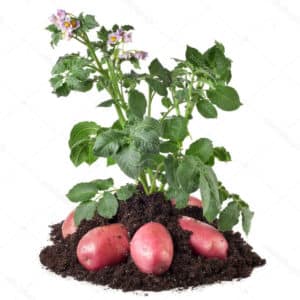
The underground part of the stem produces long shoots (stolons), at the tops of which tubers are formed. Stolons are easy to distinguish from roots - they are thicker and lighter in color. The length of the stolons will determine the size of the potato bush nest - scattered or compact.
Seedlings have simple leaves, while mature plants have complex pubescent leaves. The leaves are arranged spirally on the stem, consisting of a central petiole and several pairs of lateral lobes, always ending in a single leaf lobe. At the junction of the petiole with the stem there are stipules.The leaves die off after the plant flowers, bears fruit, and forms tubers.
The color of the stems and leaves varies from light green to dark green. Anthocyanin pigmentation is possible - depending on the type of soil and variety, the tops can change color, taking on a purple or reddish tint.
From two to ten flowers are collected in inflorescences-curls located at the top of the stem. The petals are white, pale pink or purple in color and are collected in a five-leaf corolla. Later, in place of the flowers, fruits ripen - berries with a diameter of 2 cm, similar to a green tomato, with small seeds. They ripen in the fall, acquiring a pleasant strawberry smell, but they are not eaten as food because they are poisonous.
Attention! The above-ground parts of potatoes (leaves, stems, fruits, green tubers) contain a poisonous plant substance, solanine, which, if consumed, is dangerous for humans and animals.
There are two types of potato root system:
- in those grown from seeds - a taproot, with a central root and a large number of small root processes;
- in those grown from a tuber, it is fibrous, consisting of root systems of individual stems: sprout, near-stem and stolon.
The plant is propagated by seeds (for breeding new varieties) and vegetatively (by dividing the tuber or sprouted sprouts). A plant grown from a tuber produces a harvest in the first year.
Characteristics of raw materials
Among staple foods, potatoes are in fourth place after wheat, corn and rice.
The tubers are not only suitable for food; a significant part of the crop is used as technical raw material for the preparation of starch, ethyl alcohol, glucose and animal feed.
Potatoes produce abundant harvests without much effort and easily adapt to different climatic conditions.
Many people believe that a tuber is the fruit of a potato. In fact, this is a modified shoot in which starch, sugar and other substances necessary for the development of the plant accumulate. This explains the high nutritional value of the tubers. Real fruits, as already mentioned, grow on the above-ground part of the stem and are poisonous.
Potato tubers begin to form with the appearance of the first flower buds.
The shape and color of the tubers depend on the variety, type of soil and climatic growing conditions:
- three main types of shape - round, oval, elongated;
- peel and pulp colors - white, pink, purple, red, yellow.
The skin of the tubers is dense, smooth or rough. On the surface, ocelli (buds that develop into new shoots) and lentils are clearly visible - small black dots through which the plant “breathes”.
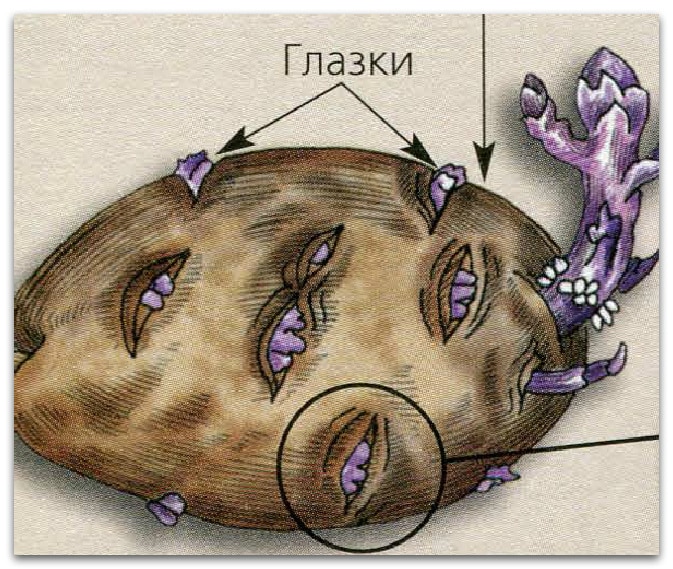
Potatoes are grown in open ground and greenhouses. It is planted when the top layer of soil warms up to +8...+10°C and the air temperature is around +20°C.
The plant is light-loving, not very demanding on soil composition, but produces the greatest yield on light and medium loams. The water requirement is average, potatoes tolerate short droughts well, but a large amount of moisture during the flowering period contributes to a rich harvest.
In the photo there are potatoes.
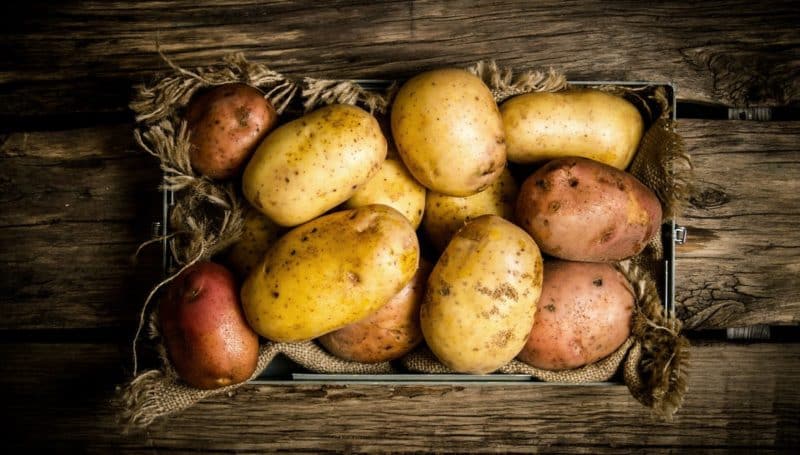
Which family does it belong to?
Solanum tuberosum L. is a perennial herbaceous tuber plant. Potatoes (like peppers, eggplants, and tomatoes) belong to the Solanaceae family. Another name for potatoes is tuberous nightshade.
Systematic group of potatoes:
- domain: Eukaryotes;
- kingdom: Plants;
- department: Angiosperms;
- class: Dicotyledons;
- order: Solanaceae;
- family: Solanaceae;
- genus: Nightshade;
- type: Potato.
There are more than 2300 nightshades plant species, among which are not only herbs and shrubs, but also trees. Solanaceae are united by a common feature - the pynopetal corolla, which is formed from five fused petals. Fruits are capsules or berries.
Among the nightshades there are many ornamental plants with a pleasant smell, such as fragrant tobacco And petunia, as well as many species that people use for food: potatoes, tomato, eggplant, bitter and sweet capsicum pepper, melon pear, physalis.
Reference. Potatoes and tomatoes were brought to Europe as ornamental plants.
There is a hybrid of potatoes and tomatoes - tomato - a miracle plant with potato tubers and tomatoes on one bush. TomTato - a development by British scientists - allows you to get about 500 tomatoes from one bush cherry and several kilograms of white potato tubers.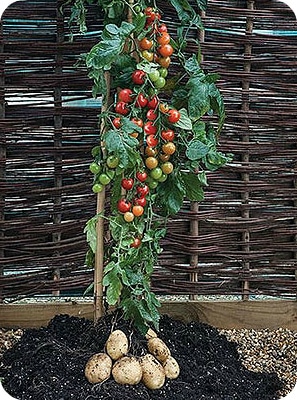
wild potatoes
It is still found in South America. It has lumpy, bitter tubers the size of a walnut. Peruvian Indians found a way to make wild potatoes edible. After some time, potatoes became the main food of the peoples of Latin America. Each Peruvian family grew its own variety of potatoes, passing on knowledge about the selection of an amazing plant by inheritance.
Having arrived in Europe more than 400 years ago, potatoes were long considered a poisonous plant. The vegetable became widespread only in the 18th century, becoming a staple food for many peoples.
Reference. The first description of the strange plant was made by Cieza de Leon, a Spanish historian and conquistador: “...they call Papas, like truffles, after boiling they become as soft inside as boiled chestnuts; it has neither a shell nor a seed, only what truffles have, because it is formed underground, like them.”
Since then, breeders have been constantly working on the taste, increasing the yield and nutritional value of potatoes. Modern potato varieties are very different in yield and size from their wild ancestor, yielding up to 2 kg of tubers from one bush.
Characteristics of wild potatoes
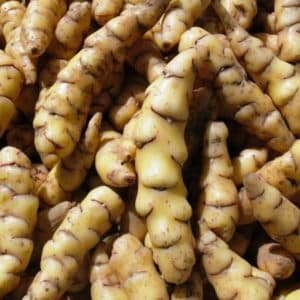
Most varieties of wild potatoes have been cultivated unchanged since the 18th century, propagated by seeds to maintain the purity of the species. Wild potatoes are characterized by low productivity, late ripening, and are grown on private farms. The price of wild potatoes is significantly higher due to the use of manual labor.
The appearance of the ground bush, the color of the stems, leaves and flowers depends on the variety of wild potato. The root system is fibrous, with a small number of stolons and small tuberous tubers.
Varieties of wild vegetable
However, recently wild varieties of potatoes that have not been subjected to selection for two hundred years have become widespread. The unusual taste of wild potato tubers is appreciated by gourmets.
Wild Potatoes Anya
Russian title: Wild White, Anna's Fingers. Potatoes with long, lumpy tubers about the size of your index finger, with pinkish-beige skin and white, waxy flesh. The taste is nutty.
Pink Fir Apple
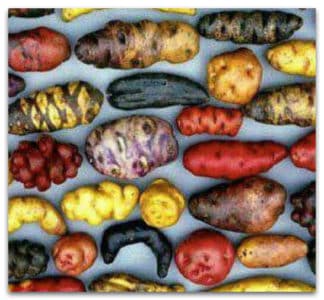
Fir apple is a wild potato with long, highly lumpy tubers with pink skin and creamy beige flesh. The taste is slightly nutty.
Belle de Fontenay
French potatoes with small, smooth tubers with yellow skin and yellow, dense, waxy pulp.
Vitelotte
Russian name - Wild Black. With oblong, highly tuberous tubers with a dense skin of dark purple, almost black color and purple pulp. It has a nutty taste and a sweetish chestnut smell.
When cooked, it does not change color, it softens strongly, turning into a puree of a rich lilac color. It has strong antioxidant properties, like all colored potato varieties.
Ozette
The oldest variety with elongated, highly tuberous tubers, the skin is brown with small dark brown “freckles” and deep-set eyes. The flesh is dense and creamy white. Taste with notes of roasted chestnuts, slightly sweet.
Conclusion
Who knows in what direction human history would have developed without potatoes. Potatoes are not only a tasty and healthy food available all year round, but also medicine and a fodder crop.